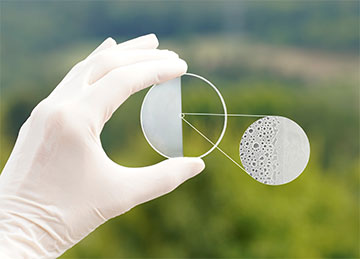
Researchers in Germany and Switzerland have developed an optical coating system that combines anti-fogging and anti-reflective properties. The new technology could help boost the performance of lidar systems. [Image: A. Gärtner, Fraunhofer Institute for Applied Optics and Precision Engineering and Friedrich Schiller University Jena]
Eyeglass wearers and camera users know about lens fogging and glare all too well. Such minor annoyances to individuals, though, could cause a major interruption in an airborne lidar mission—or result in the tragic collision of an autonomous vehicle that “sees” with lidar and cameras.
To reduce the hazards of reflections and fogging, researchers based in Germany have developed a nanostructured optical coating that cuts fogging and reflection from optical surfaces (Appl. Opt., doi: 10.1364/AO.476974). The technology, believed to be the first to fight both problems in a single coating, could improve the performance of lidar systems, smartphone cameras and other types of imaging systems.
Inspired by nature and astronauts
Research into anti-fog methods hearkens back to the 1960s, when NASA’s early spacewalking astronauts experienced fogging on the unreachable interior surfaces of their helmet visors. In response, scientists developed hydrophilic glass-coating compounds made of various polymers, hydrogels or colloids.
Anti-reflection coatings go back even further, to Lord Rayleigh’s studies of the refractive indices of tarnished and untarnished glasses in the 1880s. Ukrainian physicist Olexander Smakula invented the first interference-based coatings for a German company in 1935 (with the Allies discovering the military-secret lens technology during World War II).
In 1967, C.G. Bernhard discovered that the corneas of many moths have an outer surface of hexagonal nanostructures that create a continuous refractive-index gradient between the air and the eye, naturally eliminating reflections. Some companies use this biomimetic “moth-eye” technique to reduce lens flare.
Layers of nanostructures
For the latest research, Leica Geosystems AG of Switzerland, a maker of airborne lidar measurement systems, sought a collaboration with the optical coatings team at Fraunhofer Institute for Applied Optics and Precision Engineering (Fraunhofer IOF), Germany. The company’s goal: optical elements coated to fight fog and reflection in the near-infrared (specifically, an operating wavelength of 1064 nm).
According to lead author Anne Gärtner, a team member at Fraunhofer IOF and Friedrich Schiller University Jena, Germany, Fraunhofer IOF had already developed a process called AR-plas for etching polymer surfaces to generate an optical surface with low reflection. The procedure involves a commercial plasma ion-assisted deposition chamber, which gives researchers the ability to deposit layers of nanostructures on top of each other.
Inside the deposition chamber, Gärtner and her colleagues first laid down a water-absorbing, anti-fog polymer blend on top of a borosilicate-crown glass substrate. An additional plasma source within the chamber etched nanostructures into the polymer, which then received a thin overcoating of silica. Next, the team deposited a layer of xanthine—an organic substance recently identified as a good candidate for anti-reflection nanostructures—on top of the patterned polymer, etched a different nanostructure array, and again added a silica overcoating. The researchers gave the back side of the glass element a more conventional anti-reflection coating made of alternating layers of silica and titanium dioxide.
Putting a glass to the test
Testing the anti-fogging ability of the glass was simple: the researchers held it over a beaker of steaming hot water and observed its reaction. Measuring the anti-reflective properties of the test glass involved comparing it with optical elements with conventional coatings on both sides, then putting it into an airborne laser-scanning system for a field test. According to Gärtner, the combination of anti-fog and anti-reflective technologies has been difficult to achieve in lidar equipment.
“Since nanostructures are not mechanically stable, they are particularly suitable only for inner optical surfaces,” Gärtner says. Still, the team achieved its biggest challenge of conquering stray reflections, with a reflectance of less than 0.05% at the desired wavelength of 1064 nm.
Since the development of this nanostructured coating, Fraunhofer IOF has improved the AR-plas process, according to Gärtner. The group wants to examine the laser stability of the nanostructures, because future applications, such as an optical system for quartz cells inside quantum computers. For such cells, the anti-reflective nanostructure coatings must resist permanent laser radiation.
